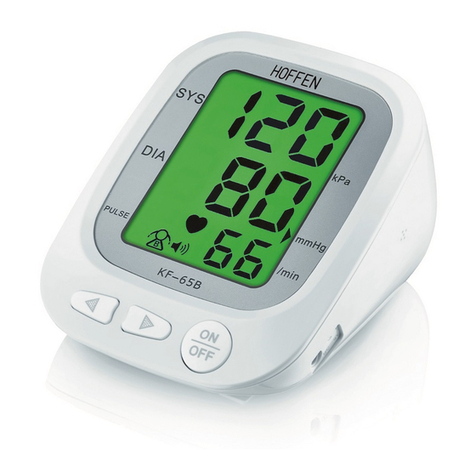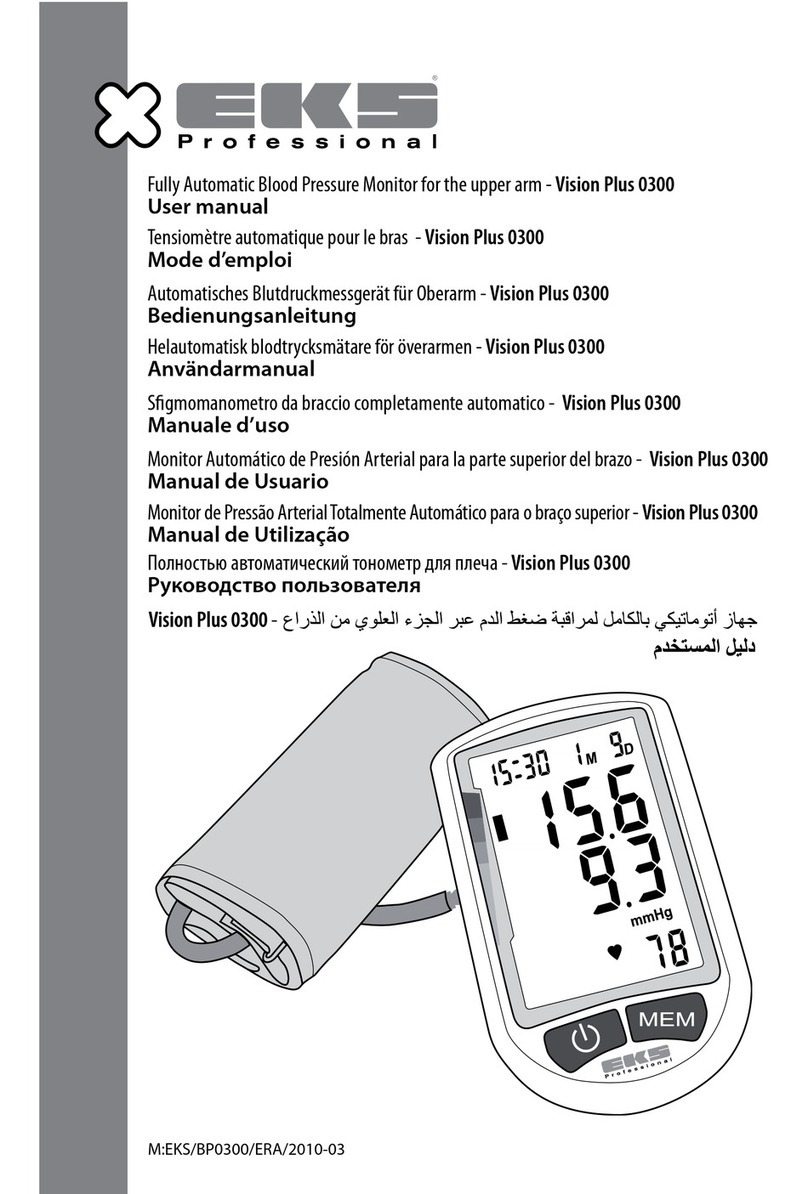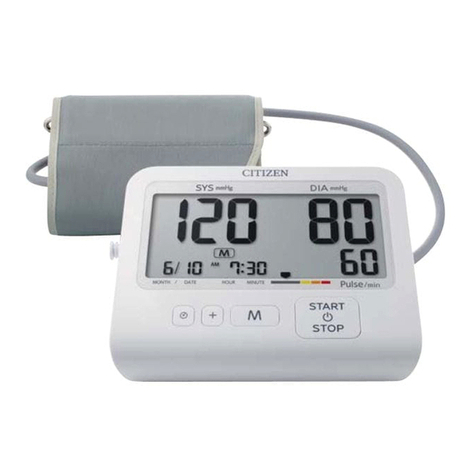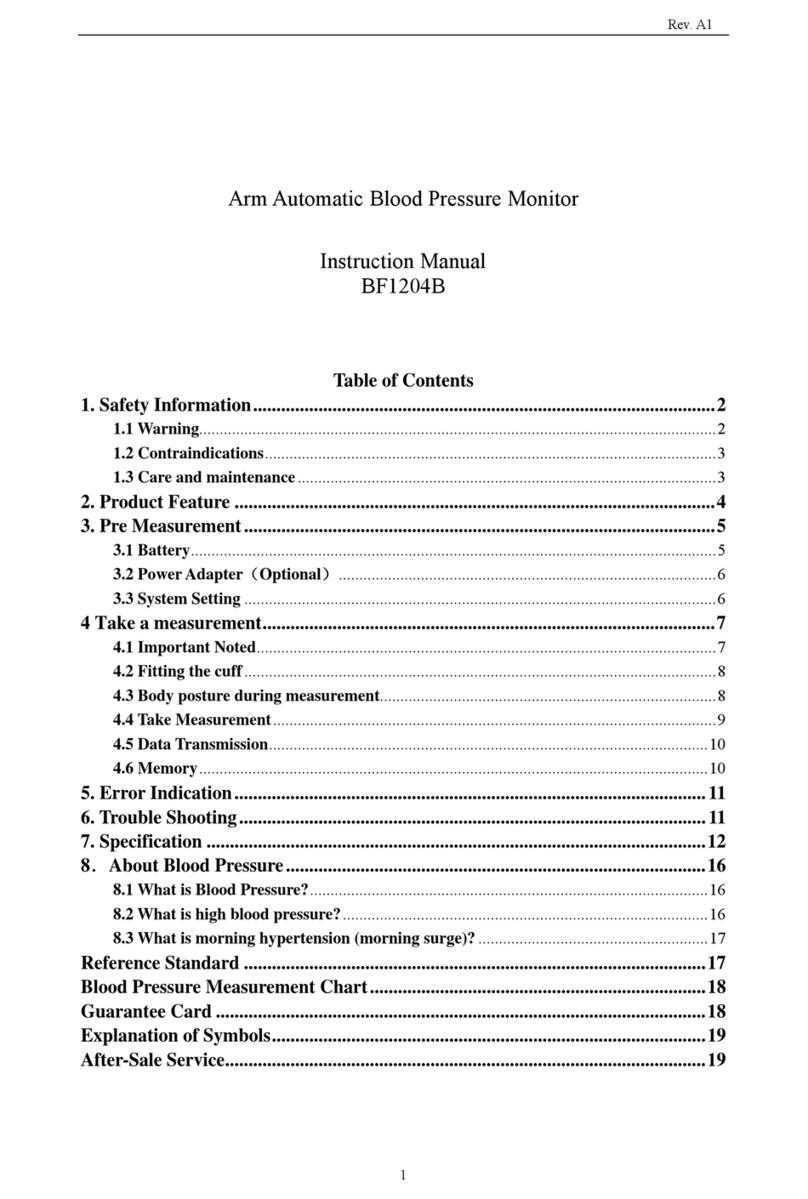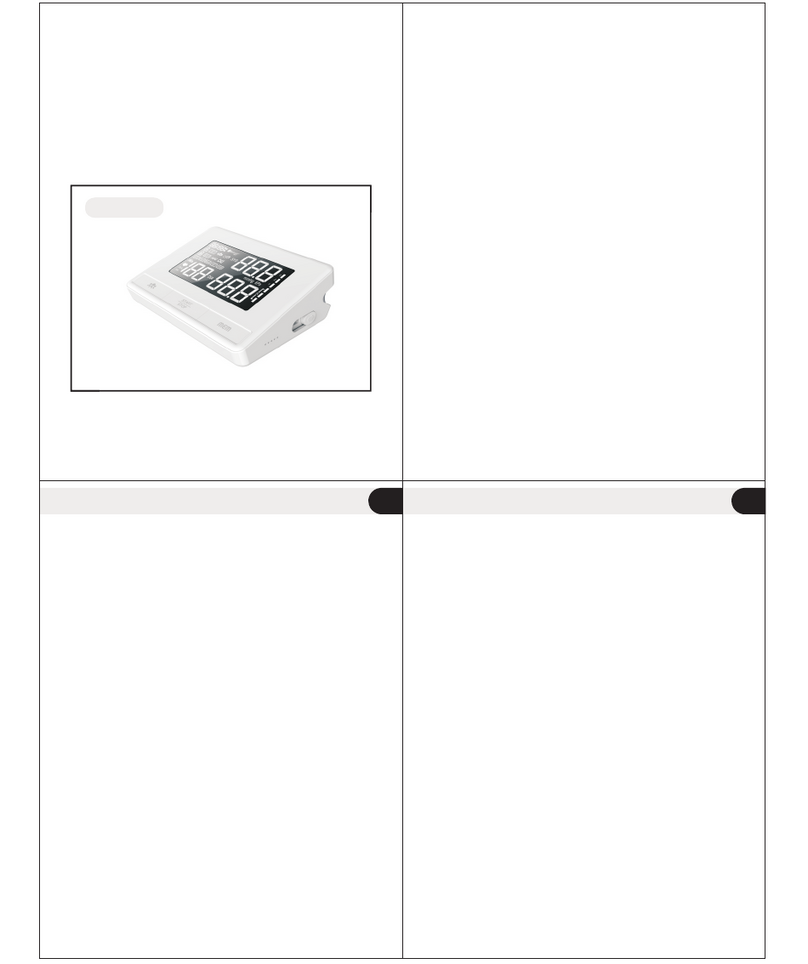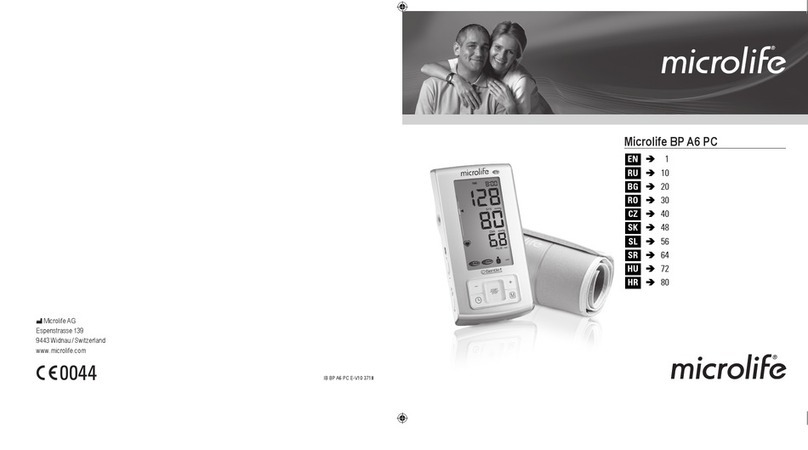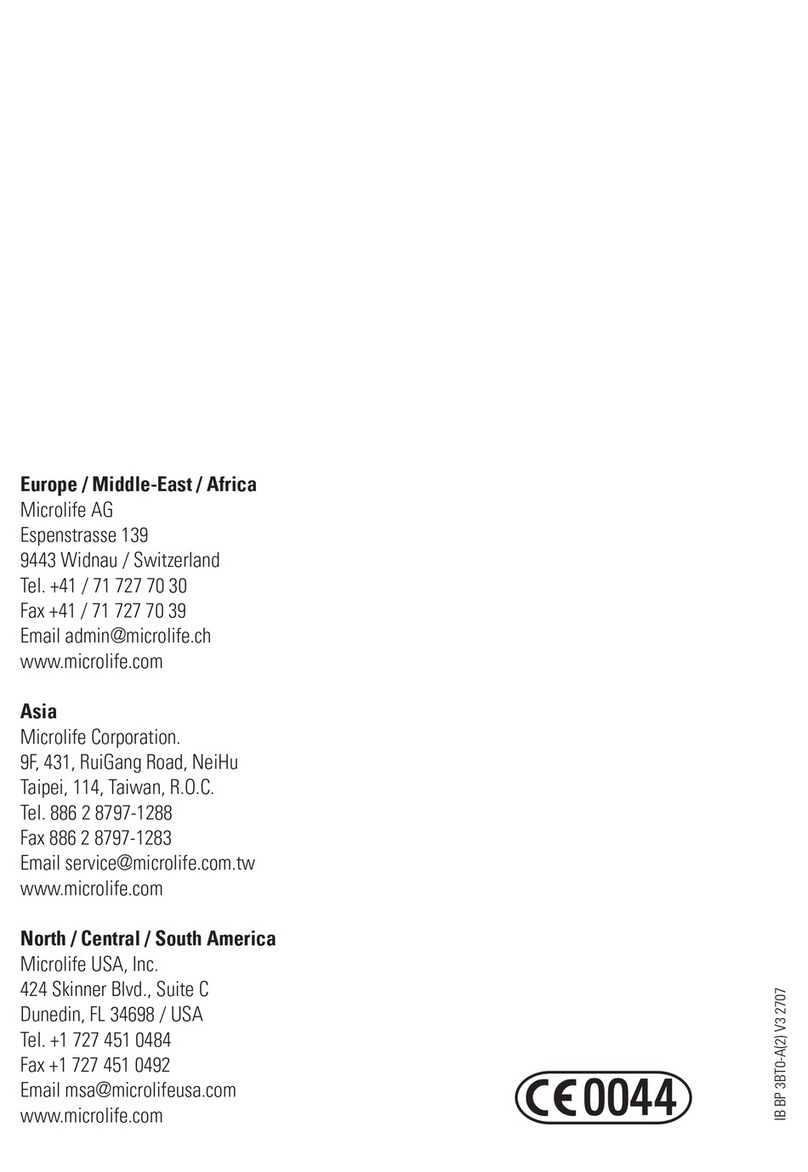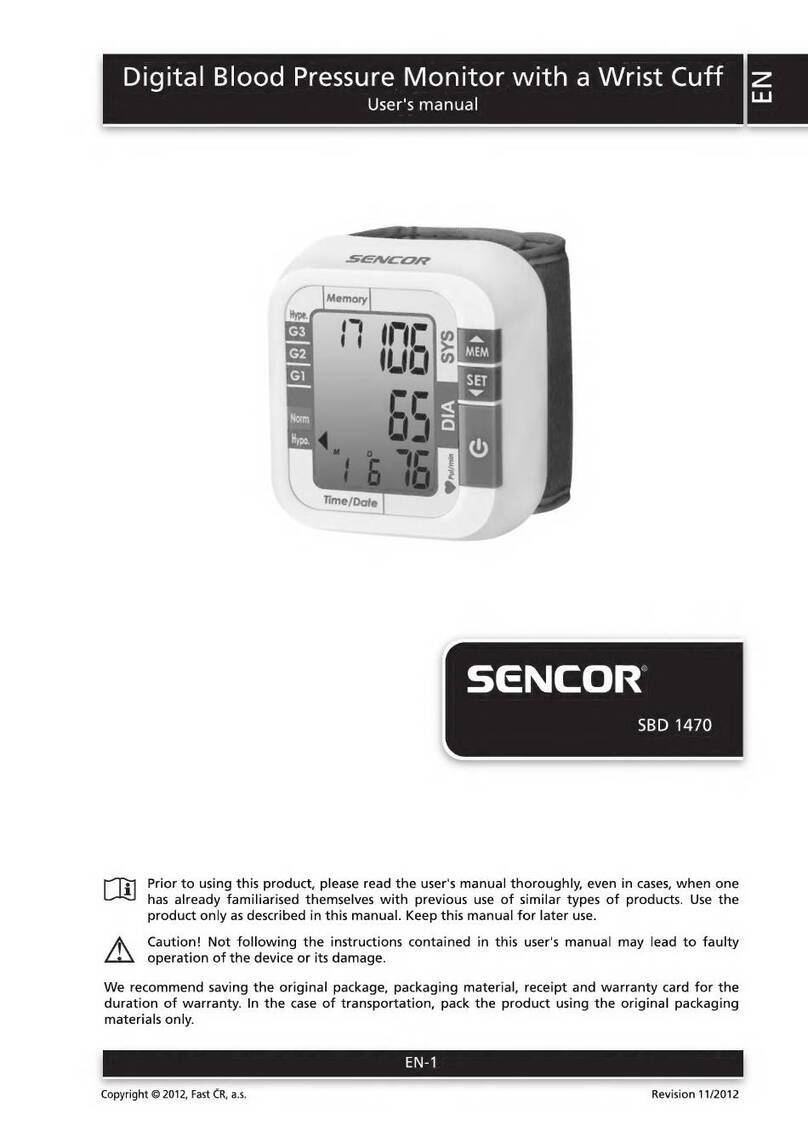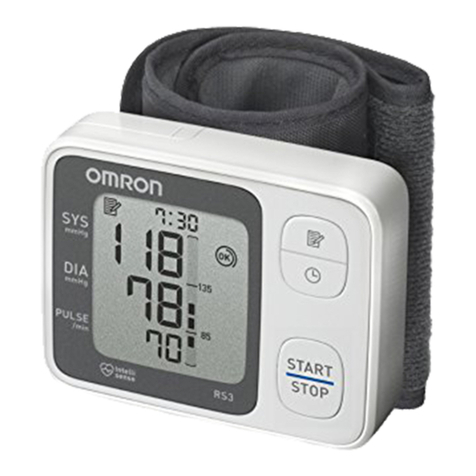Prolife PA2 BT User manual

DIGITAL
BLOOD PRESSURE MONITOR
Prolife PA2 BT
Instruction manual
Пайдалану жөніндегі нұсқаулық
en
kk
Руководство по эксплуатации
ru

2
en
DIGITAL BLOOD PRESSURE MONITOR
PROLIFE PA2 BT en
MEDICAL DEVICE NAME
Digital Blood Pressure Monitor Prolife PA2 BT.
MEDICAL DEVICE DESCRIPTION
The Digital Blood Pressure Monitor Prolife PA2 BT BT (with integrated date / time
display) is a fully automatic, digital blood pressure measuring device for use
on the upper arm, which enables very fast and reliable oscillometric measure-
ment of the systolic and diastolic blood pressure as well as the pulse frequency.
The device oers a very high and clinical tested measurement accuracy and
has been designed to provide a maximum of user–friendliness.
INTENDED USE
The device is intended for measurement of arterial pressure and pulse rate
on the shoulder (with integrated date / time display) for clinical, home and
other use.
SCOPE OF APPLICATION
It is used in all areas of medical practice, namely: cardiology, neurology, emer-
gency medical care, andrology, obstetrics and gynecology, anesthesiology and
resuscitation, sports medicine, physiotherapy exercises, narcology, neonology,
oncology, pediatrics, pulmonology, therapy, physiotherapy, phthisiology,
cardiovascular surgery, functional diagnostics, etc.
TECHNICAL SPECIFICATIONS
Type Digital Blood Pressure Monitor
Model PA2 BT
Measurement method Oscillometric, corresponding to Korotko
method: Phase I: systolic, Phase V: diastolic
Display Digital
Measurement range Pressure: 30 to 280 mm Hg (in 1 mmHg increment).
Pulse: 40 to 199 beats / minute

3
en
Static accuracy Pressure: ±3 mmHg / Pulse: ±5% of reading
Resolution: 1 mm Hg
Ination Automatic ination by internal pump
Memory function 120 records for each of two users (systolic pressure,
diastolic pressure, pulse)
Decompression Constant exhaust valve system
Power supply 4 size «AAA» alkaline batteries.
Micro-USB B
Rated voltage DC 6V
Operating temperature 5~40 ° C / 41~104 ° F
Operating humidity 15~85% RH maximum
Storage temperature -10~+55 ° C / 14~131 ° F
Storage humidity 10%~95% RH maximum
Dimensions (L x W x H) 135 x 90 x 41 (±1,0) mm
Weight
(with batteries and cu) 350 (±10,0) g
Cu pressure display range 0~299 mmHg
Safety classication Type BF equipment
Ingress protection rating IP22
Complete set
Prolife standard cu 22–32 cm,
Prolife connector, 4 «AAA» batteries, instruction
manual, warranty card.
Optionally, the device can be equipped with:
– Prolife adapter;
– Prolife cu standard 22-42 cm instead
of Prolife standard cus 22-32 cm

4
en
COMPLETENESS
Display
ON / OFF
Button
Memory
Button
Time
Button
Cu
connection opening
Power socket
User
selection
Time and date
Battery warning
symbol
Systolic value
Diastolic value
Memory symbol
Heart arrhythmia
indicator
Pulse indicator
Memory value
number
WHO scale
indicator
Pulse
Pressure unit

5
en
PUTTING THE DIGITAL BLOOD PRESSURE
MONITOR INTO OPERATION
Inserting the batteries
1. Insert the batteries (4 x size AAA 1.5 V), thereby observing the indicated
polarity.
2. If the battery warning , icon appears in the display, the batteries
3. remain 20% power, they need to be replaced soon.
4. If the battery warning , icon appears in the display, the batteries are
empty and must be replaced by new ones.
ATTENTION!
After the battery warning ,icon appears, the device is blocked until
the batteries have been replaced.
The use of 1.2 V Accumulators is not recommended.
If the blood pressure monitor is left unused for long periods, please
remove the batteries from the device.
Reading the set date
Please press the TIME button and the date will be shown
in the display.
User selection / setting the time and date
User selection
This advanced blood pressure monitor allows you to track blood pres-
sure readings for 2 individuals independently (User 1, User 2).
Before measurement, make sure you set the unit for the intended user.
Press the TIME button for at least 3 seconds. The display now indicates
the set user, during which the set user blinks. Click the MEMORY button
to select user.
3 sec

6
en
To conrm, press ON / OFF button.
NOTE:we suggest the rst person to take their pressure
to be User 1.
Setting the time and date
This blood pressure monitor incorporates an integrated clock with date display.
This has the advantage, that at each measurement procedure, not only the
blood pressure values are stored, but also the exact moment of the meas-
urement.
After new batteries have been inserted, the clock begins to run from 12:00,
after pressing the TIME button – the date is 1–01.
You must then re-enter the date and current time. For this, please proceed
as follows
1. Press the TIME button for at least 3 seconds. Select the user according
to the scheme described above, and to conrm the selection, press the
TIME button
2. The display will show four blinking characters - set the current year using
the MEMORY button.
3. Press the TIME button again. The rst character (month) will blink on the
display - use the MEMORY button to set the current month.
4. Press the TIME button again. The display will show two the last ashing
characters - using the MEMORY button set the day.
TIME
DATE
DATE DATE
DATE DATE

7
en
5. Press the TIME button again - the rst character (hours) will blink on the
display. Set the hour using the MEMORY button.
6. Press the TIME button again - the last two characters (minutes) will blink
on the display. Set the minutes with the MEMORY button.
7. Press the TIME button again to complete device settings. The input
is conrmed, the clock is turned on. The current time is displayed
on the screen.
8. To view the date, press the TIME button.
Additional Information
With each press of the button (TIME, MEMORY) one input is made
(e.g. switching over from hours to minutes mode, or altering the value by +1).
However, if you keep the MEMORY button depressed, you can switch more
quickly to nd the desired value respectively.
MEASUREMENT PROCEDURE
Measurement preparation
•Avoid eating, smoking as well as all forms of exertion directly. All these
factors inuence the measurement result. Try and nd time to relax
by sitting in an armchair in a quite atmosphere for about ten minutes
before the measurement.
•Measure always on the same arm (normally left).
•Try to carry out measurements regularly at the same time of the day,
since the blood pressure level changes during the course of the day.
TIME TIME
TIME TIME

8
en
Common sources of error
NOTE:
Comparable blood pressure measurements always require the same
conditions! In a state of physical and emotional rest.
•Take a comfortable position, relax and do not toughen muscles of the
arm subject to measurements. If necessary, use a cushion for support.
•The performance of an automatic blood pressure monitor can be iu-
enced by extreme environmental conditions: high or low temperature,
humidity, elevation of the measurement point above sea level.
•Prevent deformation and twisting of the cu tube.
•Improper (loose) xation of the cu on the arm causes false measure-
ment values.
Fixation of the cu
Insert the connector into the cu connection opening (as shown in Pic. 1) and
make sure that the connection is tight.
1. Fix the cu with Velcro fastener so that it
lies comfortably and ts snugly to your arm.
The distance between the edge of the cu
and the middle of the elbow should be
about 1~2 cm.
1–2 сm
Chief
Artery
Picture 1
Connector Cu
Cu connection opening

9
en
2. Lay the arm on a table, with the palm
upwards. The cu should be at the level
of the heart, if necessary place a cushion
under the forearm. Ensure support of the
arm on a horizontal surface. Stay calm for
2 minutes before measurement.
3. Keep your legs straight and uncrossed, lean
on the back of the chair.
Measuring procedure
When the cu is securely xed, you can start
measurement:
1. Press the ON / OFF button, air blowing
will start into the cu chamber. During this
time, the cu pressure values are continu-
ously displayed.
2. When a certain level of pressure in the cu
is reached, the air gradually comes out of it.
The display shows the numbers of the cu
pressure values. If there is a pulsation in the
artery, the heart symbol will blink on the
display.
After the measurement is
completed, the display will
show the values of systolic,
diastolic pressure and pulse
rate.

10
en
Example 1 (Pic. 2):
Systolic pressure 118,
diastolic pressure 73,
pulse 75.
Example 2 (Pic. 3):
Systolic pressure 128,
diastolic pressure 86,
pulse 68,
arrhythmia indicator .
The measurement results are displayed, until you
switch the device o. If no button is pressed for
3 minutes, the device switches automatically o, to
save the batteries.
Discontinuing a measurement
If it is necessary to interrupt a blood pressure measurement for any reason
(e.g. the patient feels unwell), the ON / OFF Button can be pressed at any time.
The device then immediately lowers the cu–pressure automatically.
Saving and recall of measurement results in the device's memory
The blood pressure monitor automatically stores each of the last 120 meas-
urement values. By pressing the MEMORY button, an average value of the
last 3 measurements (MR) as well as the last measurement and the previous
119 measurements can be displayed one after the other (MR19, MR18, ...,
MR1).
Picture 2
Picture 3
MR1 –
Memory cell 1 MR9–
Memory cell 9

11
en
Deleting all measurement results from the device's memory
Before you delete all readings stored in the memory, make sure you will not
need refer to the readings at a later date. You may keep a self–monitoring diary
and record data in writing to provide additional information to your doctor.
In order to delete all stored readings,
press and hold the MEMORY button for
at least 5 seconds until the display shows
“CL”, then release the button. The "CL"
symbol will start blinking. To permanent-
ly clear the memory, press the MEMORY
button while the "CL" symbol is blinking.
APPEARANCE OF THE
ARRHYTHMIA INDICATOR
This symbol indicates that certain pulse irregularities were detected
during the measurement.
In most cases, this is no cause for concern (for example, with the so-called
respiratory arrhythmia, which is a normal variant). However, if the symbol ap-
pears on a regular basis (e.g. several times a week with measurements taken
daily), you are advised to inform your doctor.
Please show your doctor the following explanation.
This device is an oscillometric blood pressure monitor that also analyses pulse
frequency during measurement. The device is clinically tested. The arrhythmia
symbol is displayed after the measurement, if pulse irregularities occur during
measurement.
The device does not replace a cardiac examination, but serves to detect
rhythm disturbance at an early stage.
5 sec

12
en
ERROR MESSAGES / MALFUNCTION
If an error occurs during a measurement, the measurement is discontinued
and a corresponding error code is displayed.
Error code Possible cause(s)
The device can not determine the value of the pulse
The inuence of external impact on the measurement results.
Reason: The arm was moved during the Measurement (Artefact)
The ination of the cu takes too long. Reason: the cu is not
correctly seated
The measured readings indicated an unacceptable dierence
between systolic and diastolic pressures. Take another reading
following directions carefully. Contact you doctor if you continue to
get unusual readings
If pressure is over 290 mmHg
Other possible malfunctions and their elimination
If problems occur when using the device, the following points should be checked
and if necessary, the corresponding measures are to be taken.
Malfunction Remedy
The device does not
turn on
Check batteries for correct polarity and if necessary insert
correctly
Check batteries performance and replace if necessary

13
en
The device gives an
error message sever-
al times in succession
or the measurement
values do not corre-
spond to subjective
general condition
(too high / low)
Check the positioning of the cu
Measure the blood pressure again in peace and quiet under
observance of the details following the requirements out-
lined in the “Measurement procedure” section
The results of several
consecutive meas-
urements vary sig-
nicantly
Please read and understand "The most common causes
of errors" section. Repeat the measurement again, making
sure all the rules for its execution are followed.
NOTE: The blood pressure is a dynamic value and uc-
tuates continually, therefore, a minor dierence in val-
ues is acceptable between consecutive measurements
Blood pressure
measured diers
from those values
measured by the
doctor
Keep a self–monitoring diary and show it to your doctor at
the next visit.
NOTE: A patient may experience "white coat syndrome"
at the doctor’s appointment, so the pressure readings
are higher than in a familiar home environment
Additional information
•The level of blood pressure is subject to uctuations even with healthy
people. Important thereby is, that comparable measurements always
require the same conditions (Quiet conditions)! If, in spite of observ-
ing all these factors, the uctuations are larger than 15 mmHg, and / or
you hear irregular pulse tones on several occasions, please consult your
doctor. The manufacture of the devices takes place according to the
terms of the European standard for blood pressure measuring devices
(see technical data).
•Never attempt to repair the device yourself.
•If you have questions related to the operation of the device and possi-
ble malfunctions, please contact the ocial representative of the manu-
facturer or the service center. Any manipulations with the device
(opening, mechanical or any other damage) will void all warranty claims.

14
en
IMPORTANT INFORMATION ON THE SUBJECT
OF BLOOD PRESSURE AND ITS MEASUREMENT
Causes aecting the blood pressure level
The blood pressure level is regulated by a specic region of the brain – vaso-
motor center. The blood pressure change is subject to the heart force and rate
as well as the tone and lumen of blood vessels. Relaxation of the unstriated
muscles of the blood vessel walls results in pressure reduction due to the
expansion of the lumen of blood vessels.
The blood pressure level changes periodically during cardiac activity: the maxi-
mum value (systolic blood pressure value) is observed in the period of blood
ejection out of the heart ventricles (systole), the minimum value (diastolic
blood pressure value) is observed at the end of the relaxation period (diastole).
The blood pressure values must lie within normal ranges to prevent critical
condition of health.
Which values are normal?
The blood pressure is considered to be elevated, if at rest the diastolic pres-
sure level is 90 mmHg or above and / or the systolic pressure level is above
140 mmHg. In this case, please consult your doctor. Maintenance of such
pressure levels for a long period of time pose risk to health.
Should the systolic blood pressure values lie between 140 mmHg and
160 mmHg and / or the diastolic blood pressure values lie between 90 mmHg
and 100 mmHg, please consult your doctor immediately. Furthermore, regu-
lar self–checks will be necessary.
With blood pressure values that are too low, i.e. systolic values under
100 mmHg and / or diastolic values under 60 mmHg, likewise, please consult
your doctor.
Even with normal blood pressure values, a regular self–check with your blood
pressure monitor is recommended. In this way you can timely detect devia-
tions from permissible values and take the necessary measures to prevent
hypertension and the development of complications. If for medical reasons
you have to control your blood pressure, measure it regularly at the same
time of the day and keep a self–monitoring diary so that the doctor could
evaluate changes in values.

15
en
Never use the results of your measurements to alter independently the
drug doses prescribed by your doctor.
Table for classifying blood pressure values (unit: mmHg) according to World
Health Organization.
Range Systolic blood
pressure
Diastolic blood
pressure Measures
Hypotension lower than 100 lower than 60 Consult
your doctor
Blood pressure
optimum
between 100
and 120
between 60
and 80 Self-check
Blood pressure
normal
between 120
and 130
between 80
and 85 Self-check
Blood pressure
slightly high
between 130
and 140
between 85
and 90
Consult your
doctor
Blood pressure
too high
between 140
and 160
Between 90
and 100
Seek medical
advice
Blood pressure
far too high
between 160
and 180
Between 100
and 110
Seek medical
advice
Blood pressure
dangerously high Higher than 180 Between 100
and 110
Urgently seek
medical advice!
Additional information
If your values are mostly standard under resting conditions but exceptionally
high under conditions of physical or psychological stress, it is possible that you
are suering from so–called «labile hypertension». This condition also requires
correction, please consult a doctor.

16
en
INFORMATION PROVIDED BY MANUFACTURER
The Prolife PA2 BT is intended for use in the electromagnetic environment
specied below. The customer or the user of the Prolife PA2 BT should assure
that it is used in such an environment.
Electromagnetic Emissions: (IEC 60601–1–2)
Emission Test Compliance Electromagnetic Environment
RF emission CISPR 11 Group 1
The Prolife PA2 BT uses RF energy
only for internal functions. Therefore,
this RF emission is extremely weak and
there is little chance of it creating any
kind of interference whatsoever with
nearby electronic equipment
RF emissions CISPR 11 Class B The Prolife PA2 BT is suitable for use
in all establishments, including domes-
tic establishments and those directly
connected to the public low voltage
power supply network that supplies
buildings used for domestic purposes
Harmonic emissions
IEC 61000–3–2 Not applicable
Voltage uctuations / icker
IEC 61000–3–3 Not applicable
Electromagnetic Immunity: (IEC 60601–1–2)
Immunity test IEC 60601–1–2
test level
Compliance
level
Electromagnetic
environment–guidance
Electrostatic
discharge (ESD)
IEC 61000–4–2
±6 kV contact
±8 kV air
±6 kV contact
±8 kV air
Floors should be wood,
concrete or ceramic tile.
If oors are covered with
synthetic material, the rela-
tive humidity should be at
least 30%

17
en
Electric fast
transient / burst
IEC 61000–4–4
±2 kV for power
supply lines
±1 kV for in-
put / output lines
Not applicable Mains power quality should
be that of a typical com-
mercial or hospital environ-
ment
Surge
IEC 61000–4–5 ±1 kV dieren-
tial mode
±2 kV common
mode
Not applicable
Voltage dips,
short interrup-
tions and voltage
variations
on power supply
input lines
IEC 61000–4–11
<5% UT (95%
dip in UT)
for 0.5 cycle
40% UT (60%
dip in UT)
for 5 cycles
70% UT
(30% dip in UT)
for 25 cycles
<5% UT
(95% dip in UT)
for 5 sec.
Not applicable Mains power quality should
be that of a typical com-
mercial or hospital envi-
ronment. If the user of the
upper arm stlye requires
continued operation during
power mains interruptions,
it is recommended that the
Prolife PA2 BT be pow-
ered from an uninterruptible
power supply or a battery
Power frequency
(50 / 60 Hz)
magnetic eld
IEC 61000–4–8
3 A / m Not applicable Not applicable
NOTE: UTis the a.c. mains voltage prior to application of the test level.

18
en
Immunity test IEC 60601–1–2
test level
Compliance
level
Electromagnetic
environment–guidance
Conducted RF
IEC 61000–4–6
Radiated RF
IEC 61000–4–3
3 Vrms
150 kHz to
80 MHz 80%
AM (2 Hz)
3 Vrms
80 MHz to
2.5 GHz 80%
AM (2 Hz)
3 Vrms
3 V / m
Portable and mobile RF commu-
nications equipment should be
used no closer to any partof
the Prolife PA2 BT, including
cables, than there commended
separation distance calculated
from the equation applicable to
the frequency of the transmitter.
Recommend separation
distance 3 V
d=1,2√P 80 Mhz to 800 MHz
d = 2.3√p 800 MHz to 2.5 GHz
where P is the maximum output
power rating of the transmit-
ter in watts (W) according to he
transmitter manufacturer and d
is the recommended separation
distance in meters (m).
Field strengths from xed RF
transmitters as determined by
an electromagnetic site survey a,
should be less than the
compliance level in each
frequency range b.
Interference may
occur in the vicinity
of equipment marked
with the following
symbol:
NOTE 1: At 80 MHz and 800 MHz, the higher frequency range applies.
NOTE2: These guidelines may not apply in all situations. Electromagnetic
propagation is aected by absorption and reection from structures,
objects, and people.
A. Field strengths from xed transmitters, such as base stations for radio
(cellular / cordless) telephones and land mobile radios, amateur radio, AM
and FM radio broadcast and TV broadcast cannot be predicted theoret-
ically with accuracy. To assess the electromagnetic environment due to
xed RF transmitters, an electromagnetic site survey should be considered.

19
en
If the measured eld strength in the location in which the Prolife PA2
BT is used exceeds the applicable RF compliance level above, the Prolife
PA2 BT should be observed to verify normal operation. If abnormal perfor-
mance is observed, additional measures may be necessary, such as reori-
enting or relocating the Prolife PA2 BT.
B. Over the frequency range 150 kHz to 80 MHz, eld strengths should be
less than 3 V / m.
Recommended Separation Distances:
Recommended separation distance between portable and mobile RF commu-
nications equipment and the Prolife PA2 BT.
The Prolife PA2 BT is intended for use in an electromagnetic environment
in which radiated RF disturbances are controlled. The customer or the user of
the Prolife PA2 BT can help prevent electromagnetic interference by main-
taining a minimum distance between portable and mobile RF communications
equipment (transmitters) and the Prolife PA2 BT as recommended below,
according to the maximum output power of the communications equipment.
Rated
maximum
output power
of transmitter
(W)
Separation distance according to frequency
of transmitter m
150 kHz to
80 MHz d=1,2√P
80 MHz to 800 MHz
d=1,2√P
800 MHz to 2.5 GHz
d=2,3√P
0,01 0,12 0,12 0,23
0,1 0,38 0,38 0,73
1 1,2 1,2 2,3
10 3,8 3,8 7,3
100 12 12 23
For transmitters rated at a maximum output power not listed above, the
recommended separation distance d meters (m) can be determined using the
equation applicable to the frequency of the transmitter, where P is the maxi-
mum output power rating of the transmitter in watts (W) according to the
transmitter manufacturer.
NOTE1: At 80MHz and 800MHz, the separation distance for the higher
frequency range applies.
Note2: These guidelines may not apply in all situations. Electromagnetic
propagation is aected by absorption and reection from structures,
objects and people.

20
en
CARE AND MAINTENANCE
•Do not expose the device to extreme temperatures, humidity, dust or
direct sunlight.
•The cu contains an airtight chamber. Handle it carefully and avoid
deformation when twisting or bending.
•Clean the device with a soft, dry cloth. Do not use gasoline and solvents.
Gently remove any contaminations from the cu with a damp cloth and
soapy water. Machine washing is prohibited!
•Avoid mechanical and vibration eects on the device. Handle it carefully.
•It is forbidden to open the device housing and perform any other indi-
vidual manipulations!
WARRANTY
The Digital Blood Pressure Monitor Prolife PA2 BT has a 10 years warranty
from the date of purchase. The warranty does not apply to damage caused
by improper handling, accidents, not following the operating instructions or
alterations made to the device by third parties.
The warranty is valid only in the presence of a warranty coupon, completed by
an ocial representative, conrming the date of sale and cash receipt. Infor-
mation on the warranty for consumables, parts and accessories is indicated in
the warranty card.
Warranty and free of charge service is not performed when:
•use of the device in violation of the operating instructions;
•in case of damage as a result of deliberate or erroneous actions of the
consumer due to improper or negligent treatment;
•the presence of traces of mechanical impact, dents, cracks, chips, etc.,
on the body of the device, traces of the opening of the casing, disas-
sembly, traces of attempts to repair outside the authorized mainte-
nance center, traces of moisture ingress or aggressive agents, or any
other foreign interference in the construction of the device, as well as
in other cases of violation by the consumer of the rules for storage,
cleaning, transportation and technical operation of the device, provided
in the operating instructions;
•penetration of oils, dust, insects, liquids and other foreign objects inside
the device.
Table of contents
Languages:
Other Prolife Blood Pressure Monitor manuals


